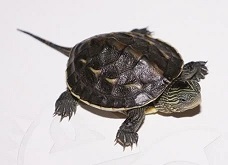Common Thread Turtle (Mauremys sinensis)
Classification: Introduced Species - While the Common Thread Turtle has been seen and identified in the states of California, New Jersey, and Texas, there are no records of any breeding populations. Sightings of this species are most likely of released or escaped pets that were imported for the pet trade.
Description: Chinese-stripe-necked turtles have a green body. As a juvenile, its carapace is grayish green and there are three distinctive ridges. As an adult, the color fades to a brown color and the two ridges gradually disappear. The plastron is ivory in color with small black spots. The male's tail is more coarse and long, while adult females will be larger than the males.
Habitat: Chinese stripe-necked turtles prefer lowland waters such as ponds, canals, and slow-moving rivers. Slow-moving creeks, swamps, ponds, lakes, and rivers at low elevations. M. sinensis can tolerate a wide range of temperatures from the cooler northern ranges of China and Taiwan to the hot tropical regions of Southeast Asia.
Range: Introduced into California, New Jersey, and Texas. The Chinese stripe-necked turtle is found in China (Hainan, Guangdong & Fujian), Taiwan and northern & central Vietnam.
Found in these States:
CA |
NJ |
TX
Diet: An omnivorous turtle, but hatchlings and males tend to be more carnivorous feeding on insects, larvae, worms, crustaceans, and carrion, but will take in variety of water vegetation. Females and older turtles will be primarily herbivorous.
Reproduction: After mating, the female turtle may lay 5-20 eggs that hatch about 60 days when needed.
Status: Chinese stripe-necked turtles are protected by the CITES and IUCN, captive-breeding Chinese stripe-necked turtles are approved. Another reason that affects its population is the invasion of red-eared sliders. In Hong Kong, mainland China and Taiwan and in some other countries, it is a popular pet turtle.
»» Kingdom: Animalia - Animals
»» Phylum: Chordata - Chordates
»» Subphylum: Vertebrata - Vertebrates
»» Class: Reptilia - Reptiles
»» Order: Testudines - Turtles & Tortoises
»» Family: Geoemydidae - Leaf Turtles
»» Genus: Mauremys
»» Species: Mauremys sinensis - Common Thread Turtle
»» Subspecies: None
This article uses material from the Wikipedia article "Chinese Stripe-Necked turtle", which is released under the Creative Commons Attribution-Share-Alike License 3.0. Content may have been omitted from the original, but no content has been changed or extended.
|








